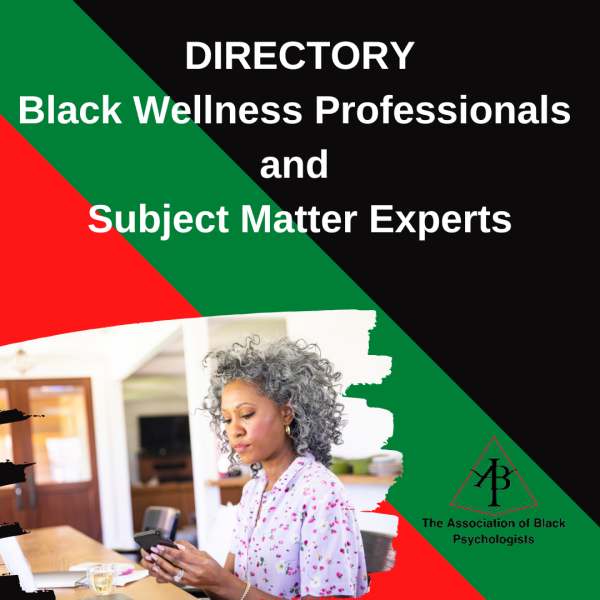Below is a summary of these wonderful articles on the psychological experiences of Black people.
Four new articles will be published in the November 2022 issue of the Journal of Black Psychology.
Dr. Marcus Watson at SUNY Buffalo State, provides the lead article. This conceptual article focuses on the theory of half-connecting (HCT, Watson, 2014) and expands its use to understand African and European worldviews in regard to human development, technologies, and everyday life as well as a foundation in understanding and treating mental and behavioral distress. It builds on African psychology and expands it. It is worth a read.
Watson, M. D. (2022). Half-connecting theory: Developing African psychology theory in a “radical beginnings” direction. The Journal of Black Psychology, 48(6), 683-725.
In the second article, authored by Taylor McGee, M.S., and Dr. Ann Kruger at Georgia State University, this quantitative study focused on the impact of parental racial socialization messages and on-campus racial microaggressions on academic outcomes. Participants were 108 African American college students attending minority serving institutions. Preparation to receive bias messages was a moderator between reporting academic microaggressions and academic engagement. Those who had received a low number of preparation for biased messages from parents and experienced high levels of academic inferiority microaggressions expressed low academic engagement. In contrast, those who receiving a high number of preparation for biased messages from parents and experienced a high level of academic inferiority microaggressions reported high academic engagement. In essence, parents preparing their children for biased messages appears to operate as a protective factor to Black undergraduate students’ academic engagement in the face of academic microaggression of inferiority.
McGee, T., & Kruger, A. C. (2022). Racial microaggressions and African American undergraduates’ academic experiences: Preparation for bias messages as a protective resource. Journal of Black Psychology, 48(6), 726-750.
The third article in the JBP’s November issue is a qualitative study about Black adolescent girls. The authors in the prior article are also authors on this paper as well. The authors are Rebekah Pollock, Taylor McGee, Johari Harris, Moriah Kearney, Kathleen McPhee, Faith Zabek, Joel Meyers, and Ann Cale Kruger. Johari Harris and Faith Zabek are at the University of Virginia and the rest are at Georgia State University. Twenty 5th to 7th grade Black girls were asked via semi-interviews to respond to a potentially risky hypothetical situation with a male peer they have met. Guided by constructivist epistemology and thematic analysis, three themes emerged. Theme 1 was “preserving safety and dignity, which reflected the basic theme of “stay safe,” which contained four variants: “don’t go,” “leave,” “staying,” or “call for help.” In essence, the Black girls’ responses reflected taking care of themselves by not going, leaving, calling for help, or staying as long as the situation was deemed safe. Theme 2 was labeled “increasing abilities” with the basic theme of “be careful” and involved negotiating situations to preserve their physical safety, which was based on the type of boy, such “unknown boy,” “older boy,” and “popular boy.” Another basic theme was to “take different approaches,” which included an “assertive response,” or a “pacifying response.” The final theme was “expect protection,” specifically from “family and friends.” These findings have implications for challenging stereotypical portrayals of Black girls as hypersexual and aggressive as well as understanding their adaptive social decision-making.
Pollock, R., McGee, T., Harris, J., Kearney, M., McPhee, K., Zabek, F., Meyers, J., & Kruger., A. C. (2022). Growing but not grown: Adolescent Black girls’ reasoning about a hypothetical and challenging social situation. Journal of Black Psychology, 48(6), 751-771.
The final article is authored by Sultan Hubbard, Brian Lakey, Shawn C. T. Jones, and Jamie L. Cage. Lakey is at Grand Valley State University, whereas the other authors are at Virginia Commonwealth University. They examined the strength of trait and dyadic relationships (situational) for Black racial identity (BRI, specifically private regard and centrality) and its linkage to subclinical anxiety and depression. Black university students (110) were asked to rate themselves on racial identity, mental health, and perceived support when with or thinking about three different relationship partners (e.g., mother, friend, siblings). Based on variance components analyses for trait and dyadic effects, they found that students with higher racial identity traits on private and centrality reported better mental health than those with lower BRI. Furthermore, BRI varied based on the relationship rated. Findings provided support for the importance of supportive others a positive BRI.
Hubbard, S. A., Lakey, B., Jones, S. C. T., Cage, J. L. (2022). Black racial identity, perceived support, and mental health within dyadic relationships. Journal of Black Psychology, 48(6), 772-792.
I enjoyed reading all of these articles and I so pleased that these authors submitted these articles to the Journal of Black Psychology. They are true contributions to the field of Black psychology.
Check out the articles and podcasts on the journal’s website (https://journals.sagepub.com/home/jbp) or go through ABPSI (https://abpsi.org/) to access the journal through your membership.



